Smolyak-Grid-Based Flutter Analysis with the Stochastic Aerodynamic Uncertainty
Abstract
How to estimate the stochastic aerodynamic parametric uncertainty on aeroelastic stability is studied in this current work. The aerodynamic uncertainty is more complicated than the structural one, and it takes more significant effect on the flutter boundary. First, the nominal unsteady aerodynamic influence coefficients were calculated with the doublet lattice method. Based on this nominal model, the stochastic uncertainty model for unsteady aerodynamic pressure coefficients was constructed with physical meaning. Afterwards, the methodology for flutter uncertainty quantification due to aerodynamic perturbation was developed, based on the nonintrusive polynomial chaos expansion theory. In order to enhance the computational efficiency, the integration algorithm, namely, Smolyak sparse grids, was employed to calculate the coefficients of the stochastic polynomial basis. Finally, the flutter uncertainty analysis methodology was applied to an aircraft′s wing model. The influence of uncertainty with uniform distribution for aerodynamic pressure coefficients on flutter boundary was quantified. The numerical results indicate that, the influence of unsteady aerodynamic pressure due to the motion of coupling modes takes significant effect on flutter boundary. It is validated that the flutter uncertainty analysis based on Smolyak sparse grids integration is efficient and accurate for quantifying input uncertainty with high dimensions.
1. Introduction
Flutter is an aeroelastic instability phenomenon, which involves the interaction of elastic structures, aerodynamic force, and inertial force. Though with high fidelity, the definite models to describe aeroelastic behavior of real aircrafts and missiles are so complicated that uncertainties or nonlinearities are inevitable. Pettit summarized the results and advances about uncertainty quantification in aeroelasticity [1] extensively. This academic paper is focused on the study of aeroelastic stability, response, and design problems with uncertainties. Most of the research topics can be classified into two aspects, either probabilistic aeroelasticity or nonprobabilistic one. For the nonprobabilistic aeroelasticity, it is of no need to know the probabilistic distributions of the uncertainties for input physical parameters and output aeroelastic response [2]. In addition, the extreme range of aeroelastic response is paid attention to, namely, “worst case” or “robust” [3]. Sometimes, the robust flutter boundary may be overconservative as there is “bad experimental data.” This is why aeroelastic analysis with probabilistic uncertainty comes into our mind. For probabilistic aeroelasticity, both the input and output uncertainties are characterized as random variables. This is originated from the areas of structure reliability analysis and system engineering. The Monte Carlo Simulation (MCS) [4, 5], the Polynomial Chaos Expansion (PCE) [6], and the Stochastic Collocation [7] methods are the well-known theories in probabilistic uncertainty quantification. However, whether they are applicable in flutter uncertainty quantification is not clear. Generally, among the three methods, MCS is regarded as the straightforward choice for uncertainty quantification of probabilistic aeroelasticity. The influence of uncertainty for structural parameters on flutter boundary was analyzed by Pitt et al. [8]. In particular, he strongly recommended that uncertainty margin should be introduced into aircraft certification process. When we are applying computational fluid dynamics to calculate the unsteady aerodynamics, MCS may increase the computational time rapidly [1, 9]. Hence, the potential of PCE method was tremendous in the field of computational aeroelasticity due to its high efficiency. In this method, the uncertainties of inputs and outputs of aeroelastic system are projected into a stochastic space. Pettit et al. successfully applied the PCE method to the analysis of aeroelastic limit cycle oscillations [10, 11]. The stochastic basis construction of the PCE method for harmonic oscillations is an outstanding contribution in his research. The advantage and drawback of MCS and PCE were compared thoroughly by Badcock et al. [12]. However, the present research of stochastic uncertainty quantification in aeroelasticity is mainly determining the effect of the structural uncertainty on aeroelastic stability. However, few of published works are about the uncertainty modeling and quantification of unsteady aerodynamics. Due to the importance of unsteady aerodynamics on flutter boundary, the effect of stochastic aerodynamic uncertainty on flutter velocity will be studied and quantified in the present work. First, the stochastic uncertainty model of aerodynamic pressure in the frequency domain was constructed. Combined with the widely used pk method, the nonintrusive PCE method is developed to analyze the influence of aerodynamic uncertainty on flutter boundary. Since the dimension of aerodynamic uncertainty is moderately large, the computational time of full tensor-product integration increases exponentially. Hence, the modified numerical integration method, namely, Smolyak sparse grids numerical integration algorithm [13], is developed to calculate the formulation of uncertain flutter boundary. Finally, a numerical example of aircraft’s wing model is applied to validate the flutter uncertainty quantification framework.
2. Nominal Flutter Solution: pk Method
The above aeroelastic equation is represented under the system of the modal basis coordinates. q represents the modal coordinate vector. M0, C0, and K0 are the generalized mass, damping, and stiffness, respectively. Q0 is the generalized unsteady aerodynamic influence coefficients. It is related to the Mach number Ma and the reduced frequency k. represents the dynamic pressure and V is the free-stream velocity.
The procedure of flutter solution with pk algorithm is as follows, given the flight velocity Vand an initial value of k, for each mode, solving the characteristic equation of (4) to obtain an eigenvalue p. Comparing its imaginary part of p with k, iterating the above equation until the discrepancy between the imaginary part of p and k is small enough. Then, the frequency and damping are obtained at this given flight velocity V. The same procedure is repeated for several velocities. The flutter velocity Vf and frequency ωf will be reached with the zero damp at a certain velocity.
3. Stochastic Uncertainty Model for Aerodynamics
3.1. Uncertainty Model for Aerodynamic Pressure Coefficients
With this uncertainty model, it is easy to understand the physical meaning of aerodynamic perturbation manner. Moreover, its uncertainty distribution may be measured by the wind tunnel test. The advantage of introducing the hypothesis is that the uncertainty size is much less than the aerodynamic panels in most general cases. This handling can reduce much time in the numerical calculation. However, the drawback is that the pressure coefficients on all patches are perturbed in the same manner.
3.2. Analysis of Flutter Uncertainty
After the coefficients of polynomial basis are calculated, is substituted into (16). Hence, the relationship of flutter velocity and aerodynamic uncertainty can explicitly be represented. Consequently, the influence of aerodynamic parametric uncertainty to aeroelastic stability can be quantified, which helps engineers make reasonable decision of aircraft design.
3.3. Numerical Integration of Smolyak Sparse Grids
In order to solve the flutter equation of (14) with uncertainty, the coefficients of polynomial basis in (16) should be estimated by (19) firstly. In this section, we will develop an algorithm to calculate the numerical integration in the numerator efficiently.
For discrete function, we have several methods for numerical integrals with high dimensions. Those include the sampling-based MCS method, the point collocation method, and the full tensor-product numerical integration one. MCS is to sample the uncertainty within the density of the weighting function and to calculate the expectation of the response-basis product. It is different from the above direct MCS for response. The MCS here is only employed for determining the coefficients of polynomials not to quantify the flutter uncertainty directly. The point collocation method, known as stochastic response surfaces method, solves a least square response equation to best match the response values. It is more feasible than the MCS method since its number of collocation points is much less [15]. The extension of tensor-product for one-dimensional quadrature is a direct approach to estimate the multidimensional integrals in (19) for several uncertainties.
From the comparison of (20) and (21), it can be seen that the Smolyak sparse grids integration only accounts for the collocation point whose index is between lw + 1 and lw + NM. It can significantly reduce the number of integration points to improve the computational efficiency.
4. Numerical Example
An aircraft’s wing model is selected to validate the flutter uncertainty analysis. Its structure and finite element model are shown in Figure 1. The finite element model is used to calculate the model’s modal frequencies and modal shapes. Its aerodynamic model is based on the subsonic DLM. When the aerodynamic uncertainty is not considered, the flutter velocity of the wing model is 36.8 m/s and the frequency is 5.71 Hz by the nominal pk method. The velocity-frequency plot shows that the coupling of the wing’s second bending mode and the first torsion mode results in occurrence of flutter phenomenon.
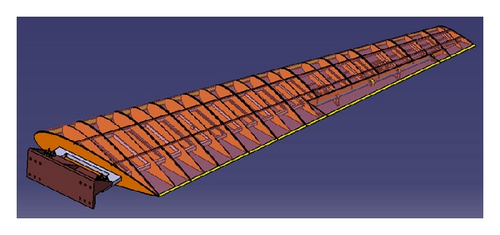
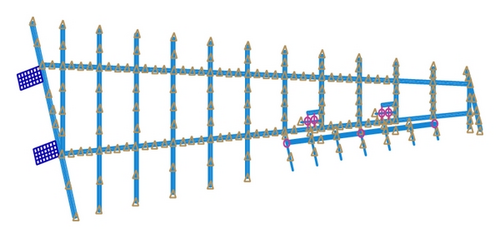
Afterwards, the stochastic uncertainty for the aerodynamic pressure is considered to quantify flutter uncertainty. Here, the uncertainty level wi of 0.1 is given for the aerodynamic pressure coefficients. It means that the calculation error of the aerodynamic force due to the modal motions may be up to 10% of their nominal values. The four parametric uncertainties are described as random variables with independently uniform distribution.
First, the MCS is employed to simulate the distribution of flutter velocities [17] numerically. It is regarded as a criterion and a basic method for comparison. 10000 random samples are simulated on a Thinkpad T430 laptop with computational time of 4814 seconds. The simulation error for MCS is 1%, approximated with the sampling number [16]. According to the statistic data of these input and outputs samples, the mean value of flutter velocity is 36.5 m/s with its standard error of 0.7905 m/s. In this specific random simulation, the flutter velocity scatters from 35.1 m/s to 38.3 m/s.
Our objective is to enhance the efficiency of flutter uncertainty analysis. Hence, the PCE approach along with different integration algorithms was applied for comparison. A straightforward PCE approach is to utilize the MCS simulation results. Naturally, the stochastic aerodynamic samples and flutter velocities obtained by the MCS above were employed to estimate the coefficients of polynomial basis in (16). Therefore, the flutter uncertainty can be represented explicitly by the stochastic polynomials, whose stochastic data is shown in Table 1, compared with different orders of Legendre polynomials.
| One-dimensional polynomial order P | Mean value for flutter velocity: m/s | Standard error for flutter velocity: m/s | Velocity range: m/s |
|---|---|---|---|
| 1 | 36.5 | 0.7835 | [35.0, 38.1] |
| 2 | 36.5 | 0.7840 | [35.1, 38.2] |
| 3 | 36.5 | 0.7877 | [34.9, 38.2] |
| 4 | 36.5 | 0.7987 | [34.8, 38.3] |
| 5 | 36.5 | 0.8137 | [34.5, 38.6] |
From Table 1, we can conclude that the stochastic polynomials with only one order are accurate enough to depict the flutter uncertainty. And the coefficients for polynomials of high order are not so accurate since the velocity range in the third column of Table 1 became larger with the order of polynomials increasing. It infers that the sampling-based PCE method does not always converge with high order of polynomials. With one-order stochastic polynomials, the statistical distribution for flutter velocity is shown in Figure 2. From the comparison of the results by MCS and PCE, the two probability density functions agree well with each other. Consequently, in the following, the polynomials of one order are employed for more detailed investigation.
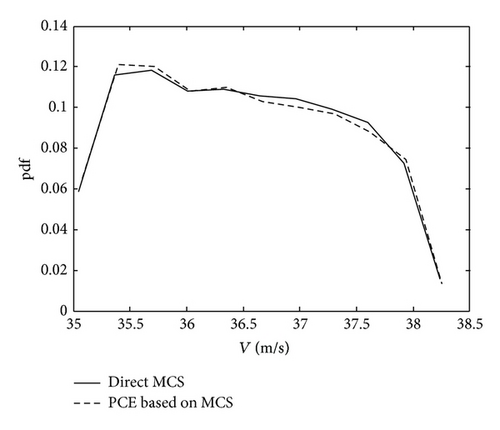
From the above equation, it is clear that the aerodynamic uncertainty due to the third modal motion, that is, the torsional mode, has significant effect on the flutter boundary. While the aerodynamic uncertainties of the second and forth modes have little effect on flutter boundary. This property can also be seen from Figures 3 and 4. In Figure 3, the flutter velocity is nearly a surface, which decreases with the aerodynamic pressure due to the torsional mode. Therefore, in order to get a high accuracy of flutter boundary, we should improve the accuracy of aerodynamics of key modes, such as the torsional mode in this example.
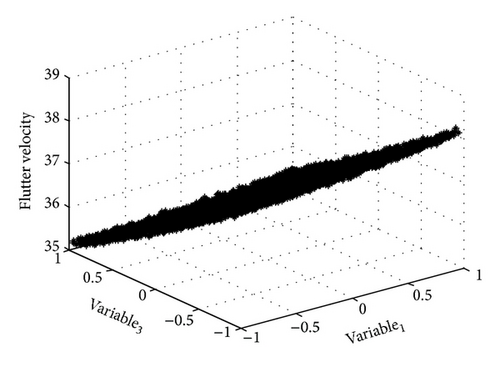
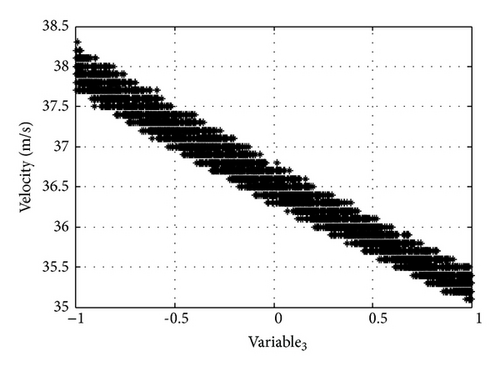
The above flutter uncertainty quantification is essentially based on random sampling, either by the standard MCS approach or by the PCE method. For this simple wing model, we still need 4814 seconds to complete flutter uncertainty quantification, let alone a complicated full aircraft model.
From the comparison of (23) and (24), it can be seen that the coefficients with the two approaches agree well with each other. In addition, the computational time (481 s) reduces much, compared with the results by MCS-based PCE method (4841 s). The results indicated that the PCE based on full tensor-production is more advantageous than the one based on MCS sampling.
The flutter uncertainty formula by Smolyak sparse gird is completely the same as the one by the full tensor-product approach. Notably, the computational time of Smolyak sparse grid is only 35 seconds. It significantly reduces the computational time while preserving the accuracy.
5. Conclusions
- (1)
It is feasible to construct uncertainty model for aerodynamic pressure coefficients which has physical meaning. The aerodynamic accuracy of key mode is vital for flutter boundary. Its calculation accuracy should be paid much attention to.
- (2)
The PCE method together with Smolyak sparse grids is applicable for aeroelastic stability analysis and especially suitable with high dimensional uncertainties. It can improve the efficiency of uncertain aeroelastic analysis, which is helpful for flutter uncertainty quantification of full aircrafts.
Conflict of Interests
The authors declare that there is no conflict of interests regarding the publication of this paper.
Acknowledgments
This work was supported by the National Natural Science Foundation of China (nos. 11302011 and 11172025) and the Research Fund for the Doctoral Program of Higher Education of China (no. 20131102120051).




